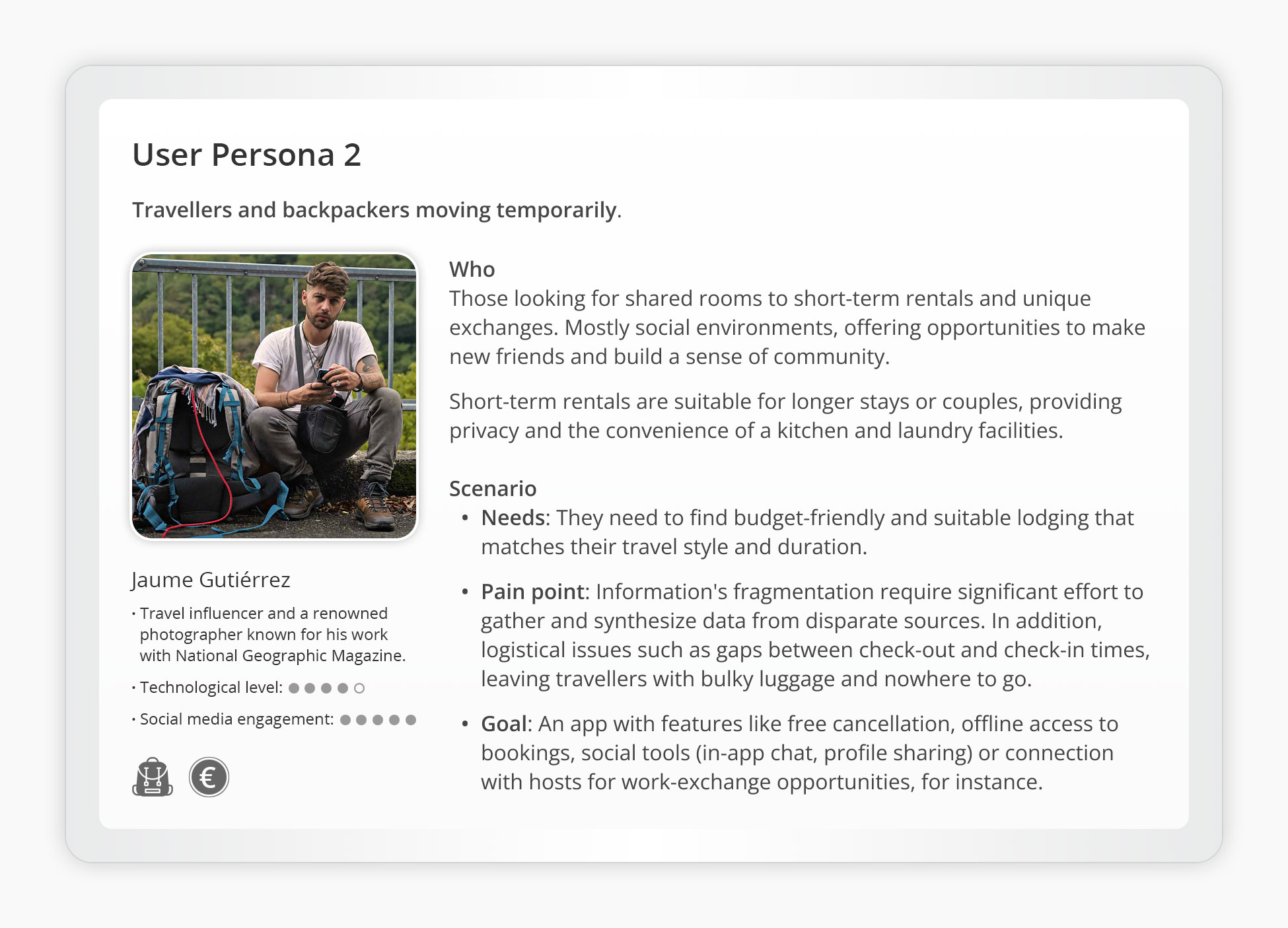Room 4U
Room rental mobile app (B2C & B2B). Freelance project, Spain.
Business context: Flatsharing & co-living accommodation / Client: Private / My role: Manage and execute the project as a Consultant/UX Designer / Target audience: Primarily the 15-34 age group who want to rent a room
Young Spaniards have been facing sharp increases in rental prices for years, with a year-over-year increase of 10.5% by August 2025. The price of homes for sale also continues to rise due to high demand and limited supply, according to Idealista, the leading real estate marketplace in Spain.
Therefore, it was necessary to address this problem by offering a solution that facilitates flexible and affordable room rentals for all budgets. Find below a video showing the user journey:
Want more?
Scroll down to view the design process!
1 Research
To tackle this problem, I carried out a fast design process which involved two tasks in the research stage: 1. Competitor analysis / 2. User personas.
1.1 Competitor Analysis
Firstly, I started with a quick competitor analysis to contextualize the problem and identify which key features to include and which to avoid. This task was crucial for understanding the main users’ concerns of the most popular room rental apps.
Native apps give better performance than web-based apps: They are faster, more responsive, and more interactive. Ideally, you should have full access to the device’s hardware and functions, such as the camera or GPS; this is essential, for example, when searching for an available room on the map accurately.
✅ Must to have
Based on feedback received through reviews in September 2025, we can summarize the following so far:
• Connect tenants directly with owners without brokerage fees.
• Real-time availability.
• Up-to-date listings (MLS databases).
• Diverse searching and filtering options.
• Map integration.
• Smooth payment and booking process.
• Visible user feedback and ratings.
• Verifications and background checks on both renters and hosts.
• Price transparency (rates, promotional offers, etc.).
• Understanding additional fees.
In short, assessing these key features can improve the overall rental experience. By examining aspects like search functions, payment processes and user reviews, we can better understand what to look for in a successful room rental app.
⚠️ Avoid
• Scams.
• Outdated listings.
• Inaccurate prices.
• Intrusive ads.
• Miscommunication with hosts.
• Discrepancies between advertised conditions and actual realities.
• Difficulty in navigating support channels.
1.2 User Personas
Who uses room rental apps? According to several online sources such as blogs and articles, a diverse range of users seeking to rent a room in a shared house or flat for both short-term and long-term rentals:
• ★ Individuals relocating for study such as students starting university.
• Individuals relocating for work such as professionals moving to a new city.
• ★ Travellers and backpackers moving temporarily.
• Those considering sharing a home to save money.
• People tired of living alone.
The current study focuses on two user personas ★ covering the different user groups listed above: 1. Individuals relocating for study such as students starting university / 2. Travellers and backpackers moving temporarily.
2 Strategy
Let’s define the problem in this second stage, as well as design guidelines in the context of the Spanish market. The goal of this project is to create an MVP product for phase 1 as a starting point.
2.1 Definition of Problem Statement
This scenario aims to represent the main problem of the user’s background in one sentence. Besides other topics such as flexibility or confidence, we may define it as follows:
[ YOUNG ADULTS who NEED to rent a room quickly BECAUSE
they want to save money while making new friends ]
2.2 Mobile-first Principle
Speed in accessing content is essential, and mobile optimisation ensures that users can navigate comfortably anytime, anywhere.
In addition, it’s always better to design for narrower screens first, then double-check and adjust for larger screens. When the product is good on a mobile device, it translates better to the rest of devices: Mobile-first is content-first.
2.3 Phase 1
Taking the Spanish market as a reference, Android is the most widely used operating system with a 78.8% market share among mobile users. However, there is a big difference by age: iOS is more popular among younger users, especially those aged 15 to 34 where iOS has twice the market share of Android.
On the other hand, the approach is to design a room rental mobile app to find, book and manage rental accommodations for both renters and property owners. The user flows included in this phase 1 only focuses on renters/tenants (B2C).
Mobile
15 to 34
iOS
B2C
Phase 2
Of course, the Android version would also be created later to fully cover all profiles. The rest of parameters below would be integrated in future versions as part of the iterative design process.
Desktop/Mobile
≥ 34
Android
B2B
3 Design
Research and Strategy provided a wider perspective about the matter. So it was time to create a potential solution, paying special attention to:
• Clarity of product data through a clean layout design visually organized on a soft 8-pixel grid which helps ensure consistency of visual spacing and element sizes.
• Frictionless user flows that minimize the effort from users, prioritizing speed in fewer steps.
3.1 Wireframes
Focused on space allocation and prioritisation of content, functionalities available, and intended behaviours. There are two user flows: 1. Registration / 2. Room rental, including the check-in process.
3.2 Mockups & Prototype
An interactive prototype that closely simulates the real product would also be provided along with a complete design system to maintain style consistency, which is a structured and scalable approach to creating consistent user interfaces, useful for both designers and developers.
Of course, the Human Interface Guidelines (HIG) was key to design this iOS app.
3.3 iOS App
Evaluation
What’s mainly shown here is the design approach for a room rental mobile app (phase 1) while improving the check-in process.
As a minimum viable product (MVP), it would integrate enough features to satisfy early customers and get feedback for future product development, aligned with business strategy. Most of the requirements have already been included, providing a starting point to keep iterating in the design process 🚀





















